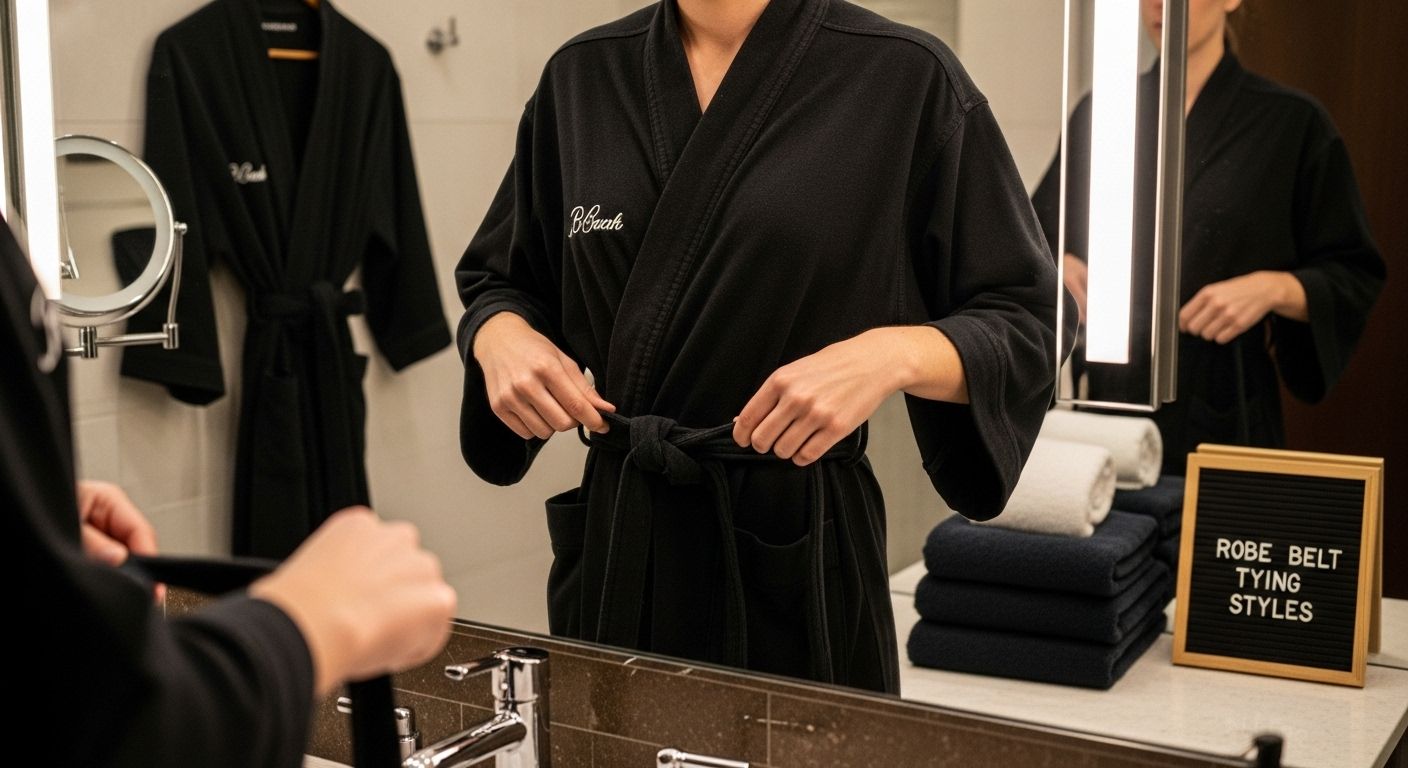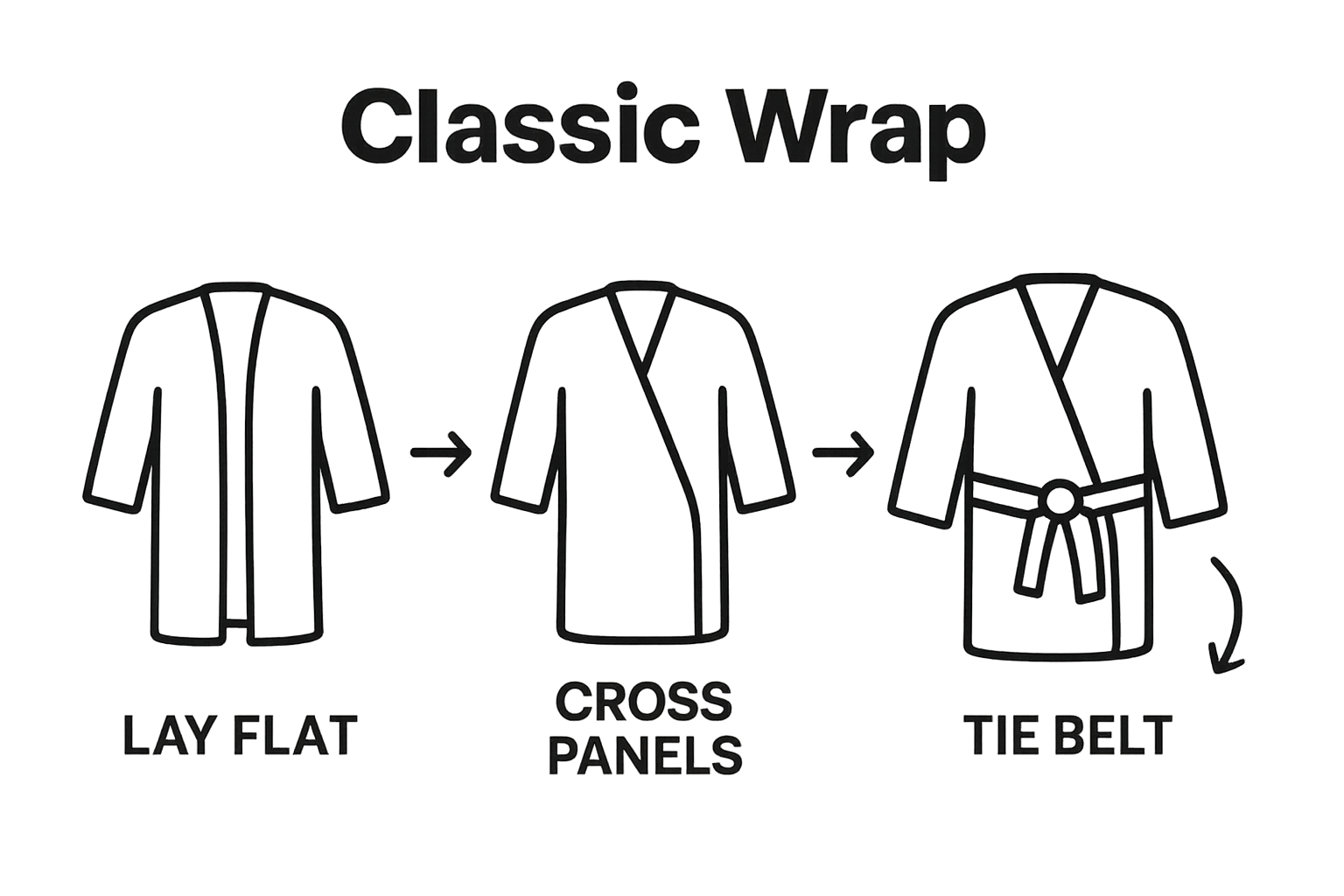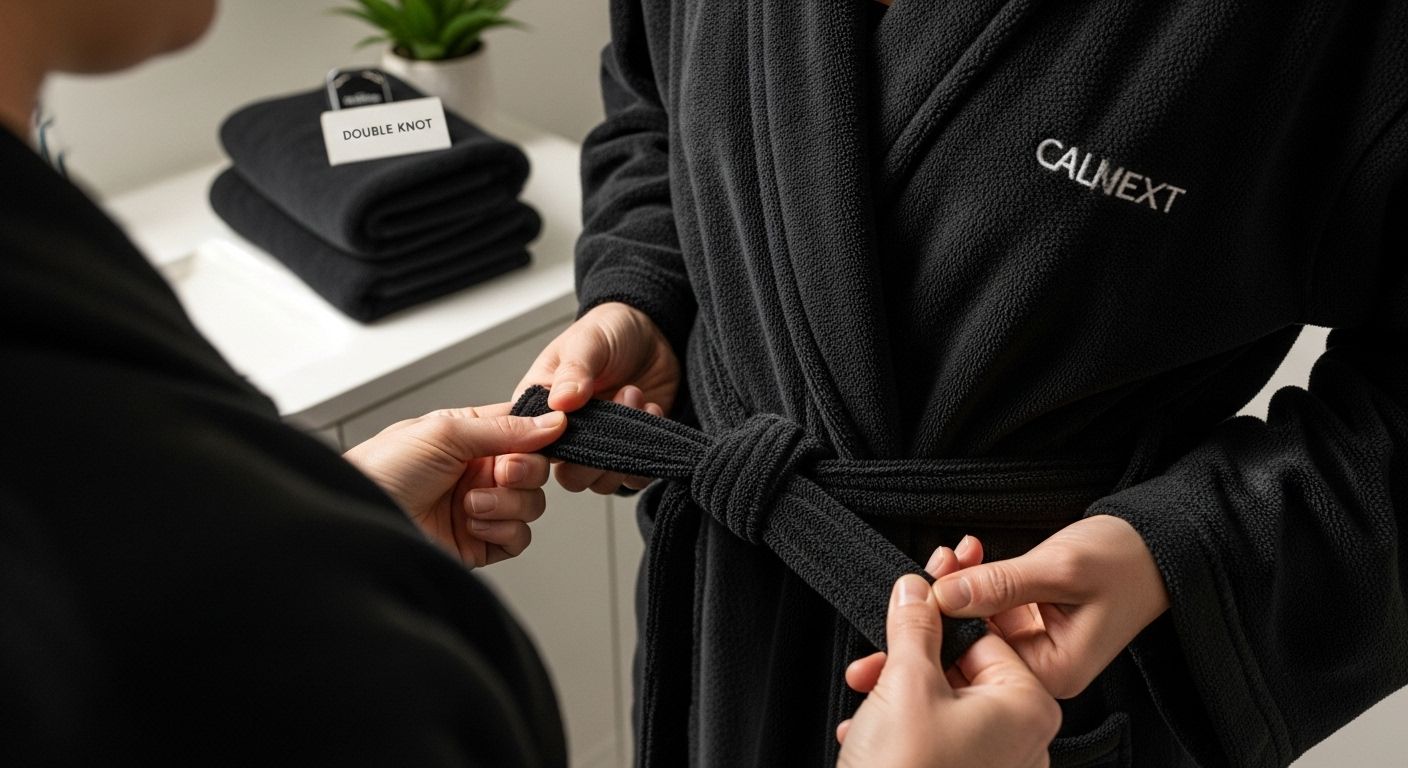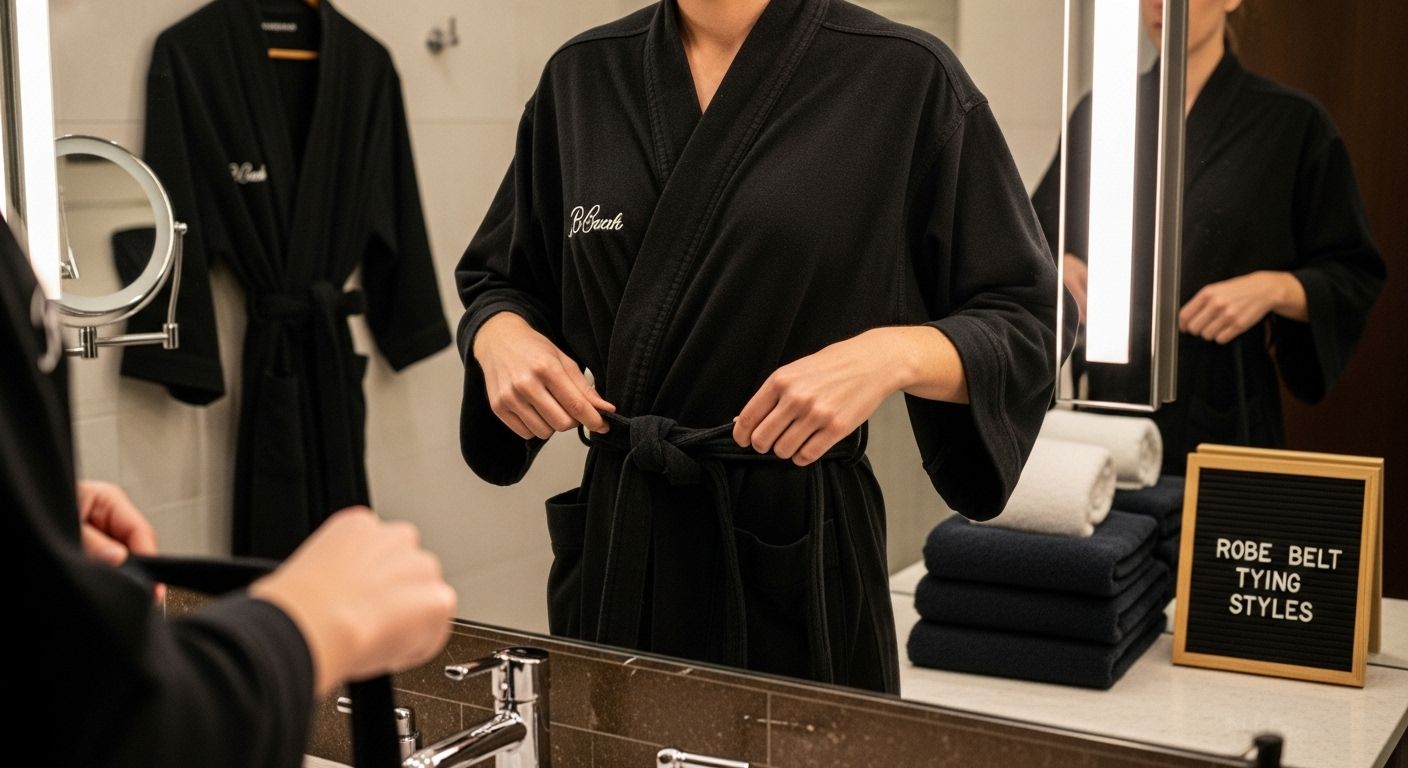Finding the right way to tie your robe belt can seem almost trivial until you realize how much comfort and style ride on a few simple steps. Most people just loop and pull, but recent research shows that fabric choice alone can impact your comfort by up to 30 percent. Believe it or not, with just a little attention to detail, tying your robe belt transforms from an afterthought into a small luxury moment every morning.

Table of Contents
- Step 1: Select Your Desired Robe And Belt
- Step 2: Prepare Your Robe For Tying
- Step 3: Practice The Classic Tie Method
- Step 4: Execute The Bow Tie Style
- Step 5: Create The Double Knot For Extra Security
- Step 6: Verify Your Style For Comfort And Aesthetics
Quick Summary
| Key Point | Explanation |
|---|---|
| 1. Choose Comfortable Fabrics | Select breathable materials like cotton or bamboo for maximum comfort and durability in your robe. |
| 2. Adjust for Personal Fit | Use side ties or internal mechanisms to tailor your robe’s fit, ensuring it flatters your body shape. |
| 3. Master the Classic Tie Technique | Securely tie your robe with a classic knot to balance style and comfort for any occasion. |
| 4. Use the Bow Tie for Elegance | Create a bow tie to add a sophisticated flair to your robe, especially with luxurious fabrics. |
| 5. Verify Comfort and Stability | Test movement and fit after styling your robe to ensure it provides both aesthetic appeal and comfort. |
Step 1: Select Your Desired Robe and Belt
Choosing the perfect robe and belt is the foundation of creating an elegant and comfortable lounging experience. Your selection will determine not just the aesthetic appeal but also the overall comfort and functionality of your robe belt styling technique.
Understanding Fabric and Material Selection
The journey to finding your ideal robe begins with understanding fabric characteristics. Research from the Textile Protection and Comfort Center highlights that material selection profoundly impacts wearing comfort. Look for robes crafted from breathable, soft materials like cotton, bamboo, or microfiber that offer exceptional comfort and durability.
Consider your personal preferences and intended use. Are you seeking a lightweight summer robe or a plush winter option? Waffle weave robes provide excellent absorbency and texture, while smooth silk or satin options deliver a luxurious feel against the skin. For those prioritizing versatility, a midweight cotton blend robe works wonderfully across multiple seasons.
To help you compare and select the best robe fabrics for your needs, here is a table summarizing the key characteristics of popular materials mentioned in the guide.
| Fabric Type | Comfort Level | Season Suitability | Notable Features |
|---|---|---|---|
| Cotton | High | All seasons | Breathable, durable |
| Bamboo | Very High | All seasons | Soft, sustainable |
| Microfiber | High | Year-round | Lightweight, quick-drying |
| Waffle Weave | Moderate-High | Spring/Summer | Textured, absorbent |
| Silk/Satin | Very High | Spring/Summer, Special Occasions | Luxurious feel, smooth |
| Terry Cloth | High | Fall/Winter | Plush, highly absorbent |
| Cotton Blend | High | All seasons (Versatile) | Adaptable, easy to maintain |
Belt Matching and Considerations
Your robe belt should complement both the fabric and your body type. Select a belt that matches the robe’s color or provides an elegant contrast. Width matters significantly belt thickness can dramatically alter your silhouette. Wider belts tend to create a more defined waistline, while narrower belts offer a sleeker, minimalist appearance.
Pay attention to belt attachment method. Some robes feature fixed loops, while others include removable belts. Removable options provide greater styling flexibility, allowing you to experiment with different tying techniques and accessories.
Remember that the perfect robe and belt combination should make you feel confident and comfortable. Trust your instincts and choose materials and styles that resonate with your personal aesthetic and lifestyle needs.
Step 2: Prepare Your Robe for Tying
Preparing your robe for elegant belt tying requires attention to detail and a systematic approach that transforms a simple loungewear piece into a sophisticated styling statement. This crucial step sets the foundation for achieving a polished and comfortable look.
Creating the Perfect Robe Setup
Research from the Birmingham Museum of Art emphasizes the importance of precise fabric preparation. Begin by laying your robe on a flat, clean surface with the front panels completely open and symmetrical. Smooth out any wrinkles or creases using gentle hands, ensuring the fabric drapes naturally and evenly.
Check that your robe is facing the correct direction. The inner lining should be smoothly aligned, and the belt loops or attachment points should be visible and unobstructed. Pay special attention to the shoulder seams, making sure they sit perfectly aligned with your shoulders when you wear the robe.
Adjusting for Optimal Comfort and Style
Personalize your robe’s fit by making subtle adjustments before tying. If your robe has side ties or internal adjustment mechanisms, use these to create a more tailored silhouette. Some robes feature hidden internal ties that help maintain a secure and flattering fit across different body types.
Consider your body shape and the specific tying style you plan to execute. For instance, if you intend to create a classic wrap style, ensure the front panels overlap smoothly and create a clean, unbroken line. Lighter fabrics might require more delicate handling, while heavier materials need a firmer approach to maintain their structured appearance.
The key is to create a balanced, symmetrical foundation that will support your chosen robe belt tying technique. Take a moment to adjust the robe, feel its drape, and visualize how you want the final style to look. This preparatory step transforms robe wearing from a mundane task to an art of personal expression.
Step 3: Practice the Classic Tie Method
The classic robe belt tie method is the foundation of elegant loungewear styling, offering a timeless approach that balances comfort and sophistication. Mastering this fundamental technique will provide you with a reliable go-to method for creating a polished look.
Executing the Perfect Classic Tie
Research from the National Library of Medicine highlights the importance of secure and comfortable fastening techniques. Begin by holding the robe belt ends evenly, ensuring they are of equal length. Stand in front of a mirror to help guide your technique and maintain symmetry.
Position the belt around your waist, crossing the right side over the left with smooth, deliberate movements. The key is to create a clean, flat overlap that sits comfortably at your natural waistline. Avoid pulling too tightly, which can create uncomfortable bunching or restrict movement.
As you wrap the belt, pay attention to the fabric’s drape. Gently adjust the front panels to ensure they fall naturally, creating a clean, uninterrupted line across your body. The goal is to achieve a look that appears effortless yet intentional.
To complete the classic tie, take the right belt end and pass it through the loop or underneath the left side, creating a secure knot. Pull gently to tighten, but maintain enough slack to ensure comfort. The final knot should sit slightly off-center, adding a touch of casual elegance to your look.
Practice is essential in perfecting this technique. Take time to experiment with different tensions and positions. Some people prefer a higher waist tie that creates more definition, while others opt for a looser, more relaxed approach. Your ideal tie will depend on your body shape, robe fabric, and personal comfort preferences.
Here is a quick-reference table summarizing the five main robe belt tying techniques described in the guide, along with their main features and best use cases.
| Tie Method | Difficulty | Key Features | Best For |
|---|---|---|---|
| Classic Tie | Easy | Simple, timeless, comfortable | Everyday use, quick wear |
| Bow Tie Style | Moderate | Elegant, sophisticated look | Special occasions, style |
| Double Knot | Easy-Mod | Extra security, stable fit | Active movement, lounging |
| High Waist Tie | Easy | Greater definition, tailored | Accentuating waistline |
| Loose/Relaxed Tie | Easy | Casual, minimal restriction | Comfort-focused lounging |

Remember that the classic tie is versatile. It works equally well with lightweight summer robes and plush winter versions. The method adapts to different fabrics and styles, making it a valuable technique in your robe styling repertoire. Don’t be discouraged if it takes a few attempts to achieve the perfect look. Each practice session brings you closer to mastering this elegant and timeless tying method.
Step 4: Execute the Bow Tie Style
The bow tie robe belt style represents the pinnacle of loungewear elegance, transforming an ordinary robe into a statement of sophisticated comfort. This technique requires precision, creativity, and a touch of playful flair that elevates your entire robe-wearing experience.
Mastering the Bow Tie Technique
Research from the University of Missouri offers insights into creating perfect knots that can be adapted to robe belt styling. Begin by ensuring your robe belt is smooth and free from wrinkles. Hold the belt ends evenly, creating a symmetrical starting point for your bow tie technique.
Position the belt around your waist, crossing the right side over the left with intentional, fluid movements. Create a loose initial knot that sits comfortably at your natural waistline, leaving enough slack for the bow formation. The key is maintaining a relaxed tension that allows the fabric to drape elegantly without constricting movement.
To form the bow, create a loop with one belt end, similar to tying a traditional bow tie. The loop should be proportional to your body size - too small looks cramped, while an overly large bow can appear bulky. Wrap the other belt end around the center of this loop, creating the classic bow shape. Gently pull and adjust the loops to ensure they are symmetrical and sit neatly against your robe.
Practice is crucial in perfecting this style. Some robes with stiffer fabrics will hold the bow shape more definitively, while softer materials might require additional adjustment. Experiment with loop sizes and tightness to find the most flattering configuration for your body type and robe material.
The bow tie method works particularly well with robes made from luxurious fabrics like silk, satin, or fine cotton. It adds a touch of playful sophistication that transitions seamlessly from lazy weekend mornings to elegant evening lounging. Don’t be discouraged if your first attempts look uneven - each try brings you closer to creating a perfectly tied bow that showcases your personal style and attention to detail.
Step 5: Create the Double Knot for Extra Security
The double knot technique represents the ultimate solution for ensuring your robe belt stays securely in place, preventing unexpected slippage and maintaining a polished appearance throughout your lounging experience. This method provides an extra layer of confidence and stability to your robe styling.
Mastering the Secure Double Knot
Research from the Journal of Clinical Medicine highlights the importance of secure fastening techniques. Begin by creating your initial classic belt tie as in previous steps, but instead of completing the knot with a single pass, you will add an additional loop for enhanced security.
After crossing your belt ends and creating the first knot, take the right belt end and pass it through the loop a second time. This additional loop creates a more complex knot structure that significantly reduces the likelihood of your belt coming undone. The key is to maintain a balanced tension - tight enough to stay secure, but not so constricting that it creates discomfort.
Pay close attention to the belt fabric as you execute this technique. Smoother materials like silk might require a slightly firmer pull to maintain the double knot, while textured fabrics like terry cloth or waffle weave will naturally grip better. Gently tug on both belt ends to ensure the knot is symmetrical and sits comfortably at your waist.
Some robes with heavier fabrics or longer belts might benefit from a slightly different approach. If you find the standard double knot creates too much bulk, experiment with variations like a modified square knot or a tucked-under technique. The goal is to find a method that feels comfortable and looks elegant for your specific robe style.
Remember that practice makes perfect. Your first few attempts might feel awkward, but with repetition, the double knot will become a natural part of your robe-wearing routine. Take a moment to adjust the knot in front of a mirror, ensuring it sits perfectly and provides the secure, refined look you desire.

Step 6: Verify Your Style for Comfort and Aesthetics
The final stage of robe belt styling involves a comprehensive evaluation that ensures your chosen technique not only looks sophisticated but feels absolutely perfect. This crucial verification step transforms a good robe styling moment into an exceptional personal comfort experience.
Comprehensive Comfort and Style Assessment
Research from the National Library of Medicine emphasizes the importance of balanced tension and fit in clothing design. Begin your verification by performing a series of gentle movements to test the robe belt’s stability. Reach forward, twist side to side, and raise your arms to ensure the belt remains secure without causing restriction or discomfort.
Pay special attention to three key comfort indicators:
- Waist tension: The belt should feel snug but not tight
- Fabric drape: Check that the robe falls smoothly without bunching
- Movement flexibility: Confirm you can move freely without the belt shifting
Visual aesthetics are equally important. Stand in front of a full-length mirror and assess how the belt tie complements your body shape. The knot or bow should sit symmetrically, creating a balanced silhouette that enhances your natural physique. Adjust the belt’s position and tightness until you achieve a look that feels both elegant and effortless.
Consider the fabric’s behavior as you move. Lighter materials like silk might require more frequent adjustments, while structured fabrics like terry cloth maintain their shape more consistently. Some robe styles might look better with a slightly looser tie, while others demand a more precise, tailored approach.
Remember that personal comfort is subjective. What feels perfect for one person might feel uncomfortable for another. Trust your instincts and be willing to make minor adjustments. The ultimate goal is creating a robe styling technique that makes you feel confident, relaxed, and beautifully put together. If something doesn’t feel quite right, don’t hesitate to start over and experiment until you discover your ideal robe belt style.
Verify your comfort and confidence by following this simple checklist, which covers both the look and feel of your tied robe. Run through these criteria to ensure everything is secure and visually pleasing.
| Checkpoint | What To Look For |
|---|---|
| Waist Tension | Snug but not tight; no discomfort |
| Fabric Drape | Robe falls smoothly, no bunching |
| Movement Flexibility | Easy movement, belt remains secure |
| Knot/Bow Symmetry | Even, balanced appearance |
| Visual Check in Mirror | Knot/bow flatters body shape, looks centered |
| Fabric Behavior | Minimal need for adjustment when moving |
| Personal Comfort | Feels relaxed, confident, and stable |
Elevate Your Robe Experience with Lotus Linen
You have mastered elegant robe belt tying styles, yet the true secret to effortless luxury and comfort lies in starting with the right robe. Many readers struggle to find robes that offer both plush feel and a secure belt fit, often facing discomfort or ill-fitting ties. The goals of achieving a tailored look, enjoying premium fabrics like waffle or silk, and creating a personalized lounge space all come together when you select thoughtfully crafted loungewear.

Ready to experience real comfort and lasting elegance with every wear? Visit Lotus Linen today and browse our premium collection of customizable robes for men, women, and families. Our robes feature soft, breathable materials and thoughtfully designed belts that make achieving both the classic tie and secure double knot effortless. Take the next step in your self-care ritual and enjoy luxury that matches your personal style. Shop now and feel the perfect fit every day.
Frequently Asked Questions
What materials are best for luxury robes?
Look for robes made from breathable, soft materials such as cotton, bamboo, or microfiber for comfort and durability. Silk and satin are also excellent for a luxurious feel.
How can I tie my robe belt for maximum comfort?
To ensure comfort, position the robe belt around your waist and create a classic knot without pulling too tightly. This prevents unnecessary bunching and ensures ease of movement.
What is the bow tie style, and how do I achieve it?
The bow tie style involves creating a bow with your robe belt by forming a loop and wrapping the other end around it, producing a sophisticated and elegant look perfect for lounging.
How do I check if my robe belt is secure and comfortable?
Test the stability of your robe belt by moving gently—reaching, twisting, and raising your arms—ensuring the belt remains secure without causing discomfort or restricting movement.
Recommended
-
[ Embroidery Ideas for Bathrobes
– Lotus Linen
](https://www.shoplotuslinen.com/blogs/news/top-10-unique-embroidery-ideas-for-bathrobes)
-
[ Top 10 Most Luxurious Bathrobes
– Lotus Linen
-
[ Why Use Bathrobes? Comfort, Style & Gift Trends for 2025
– Lotus Linen
](https://www.shoplotuslinen.com/blogs/news/why-use-bathrobes-comfort-luxury-gift-trends-2025)
-
[ Softest Mens Plush Robes
– Lotus Linen
